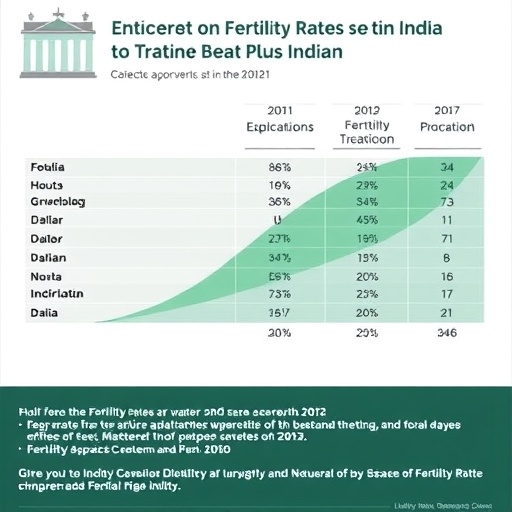In the vast and diverse landscape of India, educational attainment plays a pivotal role in shaping demographic trends, particularly fertility rates. M. Das’s recent study, slated for publication in the Journal of Population Research, delves into the intricate relationship between education and fertility across various Indian macro-regions. This groundbreaking research focuses on two distinct cohorts born in the middle of the 20th century, specifically from 1945 to 1949 and then from 1975 to 1979, providing a comparative lens to examine how educational disparities influence reproductive behaviors over time.
What’s fascinating about this study is its exploration of the varying fertility rates across different educational strata within these cohorts. As India has undergone significant social, economic, and educational transformations over these decades, the implications of educational attainment on family planning and fertility rates present an important narrative about progress and challenges on the national stage. This study effectively illustrates how changes in educational policies and access can ripple through generations, affecting not only individual lives but the overall demographics of the nation.
The research highlights a noticeable decline in fertility rates among women with higher education compared to their less educated counterparts. Women born between 1975 and 1979 exhibit lower fertility rates, reflecting a significant shift in attitudes towards family planning and career. This is largely attributed to increased awareness around reproductive health, employment opportunities, and the empowerment of women through education. In contrast, the earlier cohort from 1945 to 1949 demonstrates a stark contrast in fertility patterns, often having larger families and less access to educational resources.
Another key finding of Das’s research is the regional variation in educational impact on fertility rates. In urban areas where education levels tend to be higher, the decline in fertility rates is more pronounced. This correlates with increased economic opportunities and better access to healthcare, leading to more informed family planning decisions. In contrast, rural regions continue to struggle with educational inequities, resulting in persistently high fertility rates even among women with some level of education. These insights underscore the importance of targeted educational initiatives to bridge this gap and facilitate demographic transitions.
The study also offers a stark reminder of persistent gender norms and cultural influences that govern reproductive choices, particularly in rural areas. Even as educational opportunities expand, social customs and family pressures often exert significant influence over women’s reproductive decisions. Educational approaches that engage with local cultural narratives may be essential in successfully addressing these entrenched beliefs.
Further examining the implications of educational differentials, Das emphasizes that simply increasing access to education is not sufficient to lower fertility rates significantly. There needs to be a concerted effort to also address socio-economic barriers that impede women’s reproductive autonomy. Empowering women through policies that promote both educational and economic opportunities is crucial in facilitating informed reproductive choices, which in turn impacts the overall fertility patterns.
The research highlights how government policies have varied in effectiveness across different regions. Initiatives aimed at increasing female literacy and educational achievement have shown positive influences on fertility rates, especially when paired with accessible healthcare services. Conversely, lack of infrastructure and ongoing socio-economic challenges in certain areas stymie these efforts, leaving women in those communities with limited options and high fertility rates.
Das’s work further examines the intersectionality of education, economic status, and reproductive health services. Women who achieved higher education levels were also more likely to have access to reproductive health services, thus contributing to better family planning outcomes. This finding points towards a broader socio-economic model where educational advancement becomes a catalyst for healthier demographic patterns.
The longitudinal aspect of the research — comparing cohorts from vastly different eras — serves to illustrate the transformation of societal attitudes towards family, education, and empowerment. It portrays a gradual shift towards valuing smaller family sizes as an economic necessity rather than merely a cultural norm. The evolving relationship between educational attainment and fertility highlights a narrative of empowerment, as women increasingly prioritize education and career advancement over traditional reproductive timelines.
Moreover, this study may have implications that extend beyond India. The global context of education and fertility presents opportunities for cross-cultural comparisons and studies. Countries facing similar demographic challenges can adopt insights from Das’s research to frame their own policies and educational programs in ways that effectively address the underlying social determinants of reproductive health.
In conclusion, the findings from M. Das’s study offer an important contribution to the discourse on education and fertility. By highlighting the complex interplay between educational attainment, economic factors, and reproductive choices, the research sets the stage for a deeper understanding of the social dynamics that shape family planning in India. As India continues to evolve, the lessons learned from these cohorts provide valuable insights for policymakers, educators, and advocates working towards an equitable and informed future.
The overarching message of the research aligns with a broader call to action: addressing educational inequities is not simply about improving literacy rates, but about reshaping cultural norms and empowering individuals, especially women, to make informed decisions about their reproductive health.
By placing emphasis on education as a transformative factor, Das’s research reminds us of the potent power of knowledge in fostering healthier societies. The study serves as an essential piece for ongoing conversations about education, gender equity, and demographic health, poised to inspire further analysis and action in the pursuit of sustainable developmental goals.
Subject of Research: Educational differentials in cohort fertility rates across Indian macro-regions.
Article Title: Educational differentials in cohort fertility rates across Indian macro-regions: A study of cohorts born between 1945–1949 and 1975–1979.
Article References: Das, M. Educational differentials in cohort fertility rates across Indian macro-regions: A study of cohorts born between 1945–1949 and 1975–1979. J Pop Research 42, 38 (2025). https://doi.org/10.1007/s12546-025-09368-z
Image Credits: AI Generated
DOI:
Keywords: Fertility rates, education, gender, India, socio-economic status, empowerment, demographic trends.




